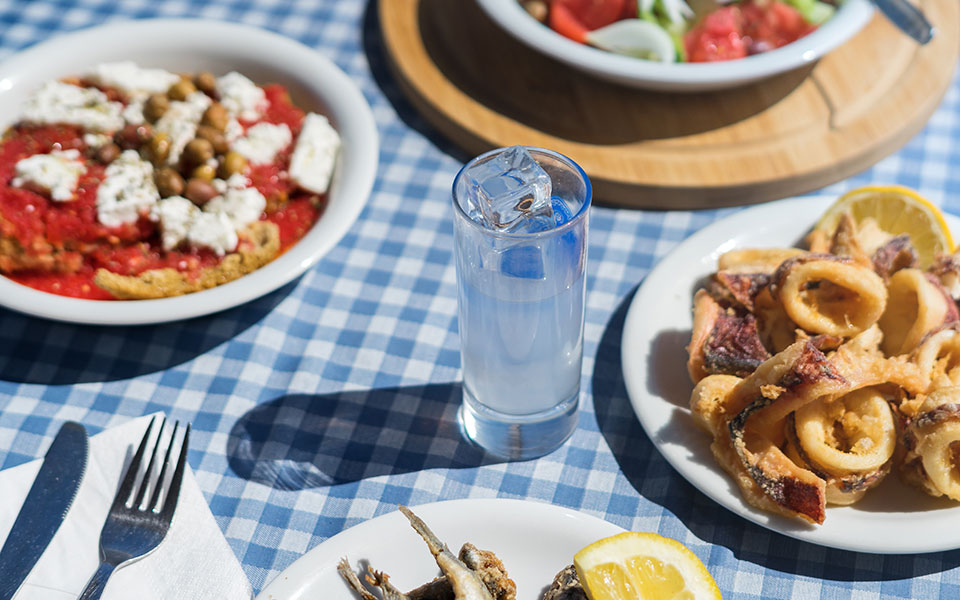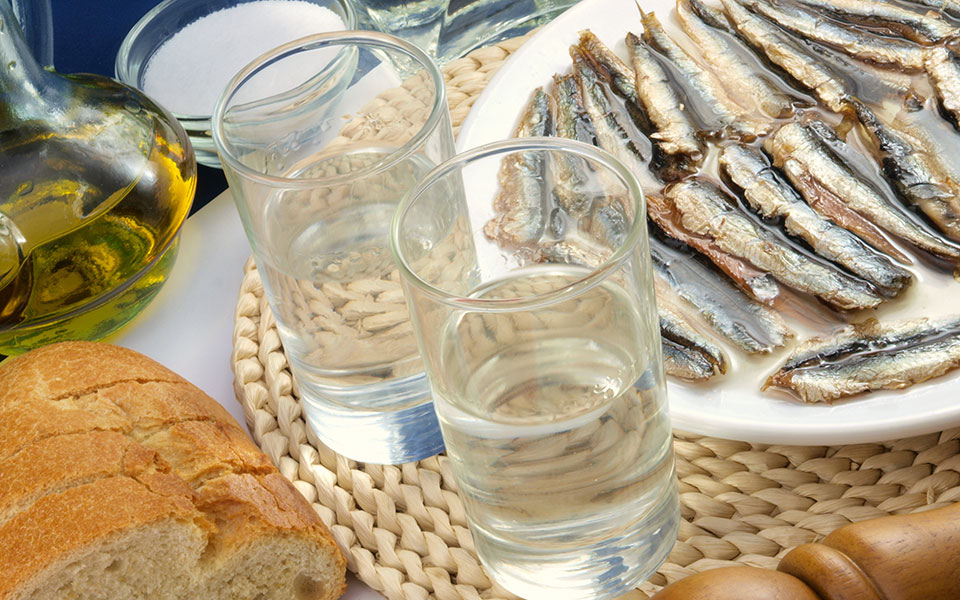If you have ever been to Greece, or had someone bring you a souvenir from Greece as an adult, you are likely familiar with at least one of Greece’s traditional spirits.
The anise-flavored ouzo is as popular with tourists as it is with the locals, and when in Greece it might be tempting to always gravitate towards whenever you fancy a drink, regardless of the setting or season. However, if you do, you will miss out on the rest of Greece’s repertoire of spirits.
For example, many Greeks will argue that tsipouro is actually a more versatile drink, and more suitable for the winter. Rakomelo (made with raki, honey and spices) is even better on cold days, as it is served warm, while in the summer, you can get the local spirits and liqueurs mixed into refreshing cocktails.
And as for those souvenirs, there are plenty of creative uses for a bottle of ouzo, raki, or traditional liqueurs. We found some great recipes to help you out.

© Paulina Kapsali

© Paulina Kapsali
Ouzo
The most famous and well-traveled of all the Greek alcoholic beverages, ouzo is a drink that reminds most people of warm days by the sea (in Greece only hardcore ouzo lovers order it in the middle of the winter).
It is traditionally produced in copper stills, where alcohol is mixed with water, aniseed, and other herbs and spices like fennel, cloves, and coriander. To be called ouzo, at least 20% of the alcoholic content must be flavored by distillation. The finished product is a dry, aniseed flavored spirit that is great as an aperitif. When water or ice is added to it, the anise makes it turn a cloudy white color, which is how most people know it.
How to best enjoy a glass of ouzo
While usually diluted with ice and water, some argue that ouzo should be enjoyed straight. If, however, you prefer a less fiery drink, make sure you pour the ouzo into your glass first, and then slowly add the water and ice. This way, the spirit is chilled slowly, keeping all the flavors intact. Or so it’s said.
The perfect pairing for ouzo is seafood. Enjoy it at seaside restaurants with meze dishes such as grilled octopus and shrimp. When cooking seafood at home, ouzo is also an excellent ingredient (see recipe below).

© Shutterstock
Recipe: Squid with Ouzo
Pour the oil into a large non-stick pan over high heat. Once hot, add the garlic and the squid, and cook for 3-4 minutes, until the squid is cooked through but hasn’t released it’s juices.
Add the ouzo and cook until evaporated.
Add the lemon balm and serve.
This recipe was first published in Greek by the food magazine Gastronomos.
Ingredients
1 kg squid, cut into rings and pieces
1 1/2 shots of ouzo
2 cloves of garlic, minced
2 tbsp fresh lemon balm
5-6 tbsp vegetable oil, for frying

Tsipouro, Raki & Tsikoudia
No matter where you go, there’s always tsipouro.
Lets start by making this clear: tsipouro, raki and tsikoudia are basically the same thing – essentially Greek versions of grappa – although experts will note that there are some variations in the distillation methods. The names have more to do with the origin of the spirits than anything else; in particular the spirits made on the island of Crete carry different names from the ones made in the rest of Greece.
On Crete, the ubiquitous clear spirit has always been referred to as tsikoudia, from the local word for pomace (tsikouda). The name raki came later, with the Turks, who used the name for their own traditional spirit to describe the one they found on Crete. Today, both names are used (it is common in bars, for example, to see the drink marketed as tsikoudia to the Greeks and raki to tourists).
Aside from the name however, the Cretan spirits only differ in that they are traditionally not infused with spices, whereas tsipouro sometimes is. Spices aside, there are no clear-cut differences in flavor between unflavored tsipouro and tsikoudia, at least none detectable to a novice.

© Shutterstock
To make things even more confusing, the most common spice to flavor tsipouro with is anise, which makes it similar to ouzo both in flavor and the cloudy white look when water is added.
No matter what you call it, it’s a potent spirit with up to 45% alcohol by volume, made 100% from grape pomace (i.e the solid residue left behind after the grapes are pressed for juice). Being distilled solely from grapes means it’s gluten free – a fact that has helped it gain popularity lately. Not that it needed a popularity boost; Greeks everywhere drink tsipouro, but the trend factor of no gluten has helped it make its way into the hip bars in Athens and Thessaloniki, where it’s used in delicious cocktails. Another new trend is barrel-aged tsipouro – a caramel colored spirit with flavor that resembles whiskey.
How to best enjoy a glass of tsipouro
Tsipouro and raki / tsikoudia are best enjoyed ice cold, or even with ice. If cold enough, serve it in shot glasses, if not, in glasses just large enough to room a couple of ice cubes. In the winter, you can also enjoy it warm in the form of rakomelo (see recipe below).
Tsipouro and meze belong together, and you’ll find tsipouro at every meze restaurant in the country. In Crete, raki is often served as a welcome and a goodbye offering, and in places like Volos and villages in Epirus, small meze dishes are provided on the house when you order tsipouro.
Recipe: Rakomelo
Stir together the ingredients in the smallest pot you have, and place over medium heat.
Remove from the heat just before it boils, and strain. Enjoy in shot glasses.
Ingredients
100 ml raki, tsikoudia or tsipouro
1 heaping tbsp honey
1 cinnamon stick
3-4 cloves

© Shutterstock
Bonus: Mastic Liqueur
While Greece produces plenty of other more and less traditional spirits and liqueurs, this is one to look out for.
PDO protected and with a growing appreciation abroad, mastic liqueur from the mastic villages (mastihohoria) on the island of Chios is becoming a product of real importance. Bartenders in Greece are now using it as a main ingredient in cocktails, and some of the best bars around the world have embraced it as well. But aside from being a trend that’s picked up steam these last few years, mastic liqueur actually has a long history.
Flavored with the pine-scented and bitter resin of the lentisk tree, this very special liqueur used to be considered a drink most suitable for women. In the 1920s, women would organize midday mastic gatherings, where they’d pair the drink with sweets and biscuits. The mastic itself has been harvested in Greece since antiquity, and was and is used to make numerous other products as well, such as gum, cosmetics, and food additives.

© Shutterstock
How to best enjoy a glass of mastic liqueur
Enjoy the liqueur chilled, in a shot glass as a digestif next to your coffee. It seems to taste better the fancier the glass (think crystal).
Mastic liqueur works very well in cocktails, especially in tangy concoctions. It’s also delicious drizzled over a fruit salad.
Recipe: Pink cocktail with mastic liqueur
Add all ingredients to a shaker with a lot of ice, and shake vigorously.
Strain into a martini glass and enjoy.
This recipe was first published in K magazine 4/3/2018.
Ingredients
30 ml mastic liqueur
20 ml lemon-scented vodka
10 ml fresh lemon juice
5 ml crème de cassis












